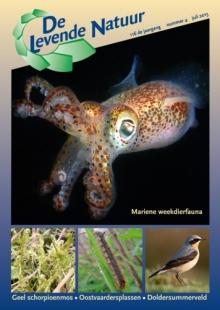De Levende Natuur nummer 4 van 2015 (English summary)
Afbeelding

Development of Hamatocaulis vernicosus in the Meppelerdieplanden
M.J. van Tweel, D.J. Bokeloh, C. Cusell, A.M. Kooijman, R. Martens, I.S. Mettrop, T. Neijmeijer& L.B. Sparrius
Hamatocaulis vernicosus is an endangered mos-species and is protected by the European Habitat-directive. Since 1996 the distribution of Hamatocaulis is expanding in The Netherlands and occurs now in six different nature-reserves. In 2004, 2007, 2010 en 2013 the species is accurately investigated in the Meppelerdieplanden. This investigation shows that the species has trippled its distribution. Although the environmental conditions for Hamatacaulis have been improved, the expansion can be seen as the filling of empty natural niches.
Recruitment of woody vegetation and effects on plant and animal diversity in the Oostvaardersplassen
R. van Klink, J.L. Ruifrok & C. Smit
We studied the factors determining recruitment of woody species and diversity of plants and animals in Europe’s oldest rewilding experiment, de Oostvaardersplassen. For this, we set up a full-factorial experiment of herbivory (no, full and partial exclosure), vegetation matrix (tall herbaceous vegetation and short lawns) and soil disturbance (mimicked by tillage) in 2010. We planted saplings of six tree and shrub species belonging to different functional groups inside and outside the exclosures: pioneers (Salix alba, Sambucus nigra), thorny shrubs (Rosa canina, Crataegus monogyna) and hardwood species (Quercus robur, Fraxinus excelsior).
As expected, herbivory had a strong negative impact on tree survival, as none of the saplings survived outside the exclosures. Inside the exclosures, almost all species showed better survival in the previously short grazed lawn vegetation, and the pioneer S. alba benefitted from soil disturbance. The exclosures caused a sharp decline in plant species richness and Stinging nettle (Urtica dioica) became eu-dominant. Exclusion of the large herbivores had positive effects on diversity of earthworms, soil macrofauna and ground beetles, and negative effects on diversity of weevils and dung beetles. Spiders, true bugs and plant- and leafhoppers showed no difference in species numbers, but large turnover in species composition.
We conclude that the creation of spatial refugia from grazing, for example by water table manipulations to create (temporal) islands or the deposition of coarse woody debris, will enhance sapling survival. This will be positive for the structural heterogeneity of the area and increase overall diversity of invertebrates and probably birds.
Long term changes of vegetation and breedings birds of the heath of Doldersummerveld
A.J. van Dijk & H.D. Heinemeijer
In the past five decades the vegetation and bird community of the heath of Doldersummerveld (258 ha, fig. 1), a nature reserve in the north of The Netherlands has changed as an effect of nature management. Since 1982 the domination of Molinia caerulea was replaced by a mixed vegetation of Calluna vulgaris, Molinia, Erica tetralix, Eriophorum angustifolium and species-rich grasslands (fig. 2). These changes were induced by the reduction of drainage, introduction of grazing by sheep and cattle, sod-cutting (26 ha) and mowing (176 ha). Besides, trees and scrub were removed. As a consequence sixteen vascular plant species of the Dutch Red List increased in abundance (table 1).
Annual breeding bird censuses were used to evaluate the impact of changes in management on heathland birds. Bird densities and diversity on average improved after diversifying heathland through grazing, mowing and sod-cutting (fig. 4). Especially breeding birds of open areas and short vegetation, including nine species of the Dutch Red List, have benefited (table 2). The number of breeding waterbirds predominantly correlated with rainfall and the amount of flooded area in early spring (fig. 3).
Strong changes in Dutch marine molluscan fauna
S.J. van Leeuwen & A.W. Gmelig Meyling
Molluscs are a very important element in marine ecosystems. They are a useful indicator for the nature quality in marine areas. The authors analysed the development of all Dutch marine mollusc species thoroughly, comparing the period 1900-1985 with the period 1985-2010. For the statistical analyses, data from all available sources (professionals, volunteers and museums) were brought together. Of the 255 species found alive since 1900, trends could be defined for 202 species. Of these, 21 species were not recorded since 1985, 51 species have declined, 46 show a stable or unclear trend, 35 species expanded their range and/or their population density and 49 species were recorded new for The Netherlands since 1985. The most important factors that contributed to these enormous changes of the Dutch marine mollusc fauna were fisheries, habitat changes caused by water management constructions such as the Delta Works, the introduction of exotic species, seawater pollution and climate change.
Flowering plants and butterflies oppressed by increasing numbers of Fallow deer in the Amsterdam Water Supply Dunes
J. Mourik
Fallow deer (Dama dama) is present in a high density of approximately ninety deer per square kilometre in the Amsterdam Water Supply Dunes. Woodland, scrub and grassland are intensively grazed throughout the year, since the area is well-fenced. A survey of the flora shows a sharp decrease in the distribution of flowering plants in recent years. Simultaneously butterfly monitoring indicates that species, especially those foraging on the declining plant species, are less numerous compared to adjacent dune areas with a lower density of deer. We conclude that continued Fallow deer herbivory will lead to severe loss of dune habitat quality and species richness.

